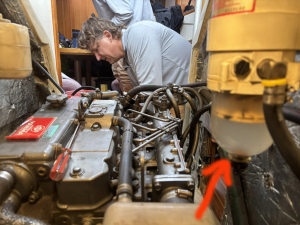When The Water Hose Goes Into The Diesel Tank
It was early in October on the morning of departure for our 5-day Northern Channel Islands trip on the Catalina 42, Betty. The student crew at the OCC school of Sailing and Seamanship in Newport Beach were working through the departure checklist, stowing the canvas and gear, running the main halyard and jib sheets, and completing engine checks.
I went to check progress with filling the water tanks and learned that the water hose had mistakenly been placed into the fuel fill on deck. Our diesel tank was topped off – with water. Right around that time, the engine that had been running, died when the water was drawn into the fuel system.
Mistakes are made all the time on these trips. While this mistake was going to delay our departure significantly, the good news was that we were otherwise 99% ready to go. We had to shift our focus and get busy with the solution so we could begin our trip. Here is what we did.
At The Dock
The OCC School of Sailing and Seamanship has a well-equipped shop, and they brought out a small transfer pump with inlet and outlet hoses, operated with a power drill. First Mate Marco took the lead and with help from the crew and the guys in the shop, Marco was going to try using that pump to draw water out of the fuel tank and then bleed the fuel system. Over the next three hours, we followed his lead in these steps:
- Connect the fuel supply hose to the transfer pump hose. This is the hose that leads from the diesel fuel tank and delivers fuel to the Racor fuel-water separator.
- Since water is heavier than fuel and settles at the bottom of the tank, it can be drawn out through the tank’s fuel pickup using the power drill and transfer pump, with the output hose leading to a large bucket.
- In this way we pumped several gallons of water into the bucket until the output stream was pure red diesel.
- We filled the Racor bowl up with fuel using the starter, bled the injectors, and started the engine.
- Water started filling the Racor bowl immediately and we began the process of draining it, letting it partially fill with water and draining it, over and over.
Right after the engine died, this is what the bowl on the Racor fuel-water separator looked like
The pump pulled water/fuel straight from the tank…
…and into the bucket
Underway
We left the dock around noon and kept a close eye on the water level in the Racor fuel-water separator bowl, noticing that it would begin to fill with an emulsified milky layer of water that we had to drain every 15 minutes or so. On one occasion, we failed to notice the problem soon enough, resulting in water being drawn into the fuel system, killing the engine.
It became apparent to me that we should not continue our planned passage to Santa Cruz Island. I expected we would have to motor overnight when the wind dropped off, and our crew would become exhausted with draining the Racor bowl and keeping the engine running in the early morning darkness. After considering the chance of becoming disabled near the shipping lanes, I realized it was time to adjust the passage plan.
- We altered course for Rippers Cove on Catalina, anchored, cooked dinner, and went to bed early.
- We took on fuel at Two Harbors, and ventured out to Santa Barbar Island, sailing whenever possible.
- When the engine was on, we watched the Racor bowl closely and continued to drain it every 15-20 minutes.
- We completed our night passage by departing Santa Barbara Island around midnight, completing a circumnavigation of Catalina.
- By the fifth day, nearly all the water was removed from the fuel tank and discharged through the Racor bowl’s drain.
How it was the first day, every 15-20 minutes
A few days in it might take an hour of motoring to get this
We filled this bottle and half of another one during the trip
My Takeaways
- If the First Mate or I am not personally supervising, place blue tape in a big X over the diesel and waste tank deck plates.
- The Racor fuel-water separator is an amazingly effective piece of equipment.
- If your engine room has the space, get one of the dual Racor systems so you can switch from the one that’s fouled to the one that’s clean by moving a lever.
- If someone puts the water hose in the fuel tank, it does not have to end the trip – but it will be a pain in the butt to deal with.
Here is how it looked 7 or 8 years ago when the water hose went into the fuel tank. Note how effective the fuel water separator is at doing its job. And, note the water is clear, not emulsified. I have received at least one comment about fuel additives causing the foamy emulsion. Does anyone know for sure?







Leave a Reply
Want to join the discussion?Feel free to contribute!